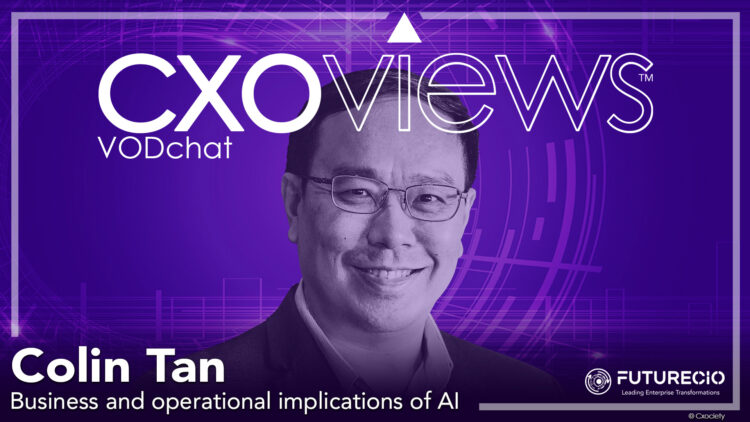At the Gartner IT Symposium 2023, The Opening Keynote was titled: The Next Era – We Shape AI, AI Shapes Us. Gartner distinguished VP analyst Don Scheibenreif declared that artificial intelligence (AI) has reached the peak of the Gartner hype cycle, that AI is everywhere, and that we are in an era where AI will infuse everything we do.
For CIOs, the challenge becomes one of identifying and facilitating this human-to-machine relationship. Gartner says where people are missing the boat is in the recognition that AI is not a technology but a business trend.
Recently, FutureCIO spoke to Colin Tan, general manager and Technology leader at IBM Singapore, to get his perspective on how AI impacts organisations in Singapore and around the region.
A foundation model is a "paradigm for building AI systems" in which a model trained on a large amount of unlabeled data can be adapted to many applications.
Foundational AI
Tan says although AI adoption has been accelerating for the last decade, organisations still face challenges in operationalising and applying AI technology.
“If you look at some of the surveys, 35% of the companies embrace AI for business, over 40% explore the use of the technology, and 54% started moving from pilot to production,” Tan says.
He posits the challenge lies in acquiring AI skills for new cases and scenarios and needing vast data sets to train them.
Differentiating foundational AI from generative AI, Tan says a foundational AI model trains on large amounts of data or unlabored data. He added that foundational AI models focus on multi-domains that can assess different aspects of business data, such as structured data, unstructured data, geospace, and mix-modality data that combines text with images.
“With the foundational model that we built like watsonx, the foundation is already there, and whatever new cases that you want to look at, whether it is looking at cyber security and different use cases, you can build data sets that are on top of the foundation model,” he explains.
Tan mentions a survey revealing that a third of organisations will leverage foundation models to accelerate AI adoption at scale within the enterprise. “With some of the early adopters, we are seeing a 70% Improvement in terms of the time-to-value leveraging on the foundation model,” he adds.
Information architecture
For Tan, information architecture is the core. “AI requires machine learning, which requires analytics. Analytics requires a robust and resilient data information architecture,” he says.
He says that the AI models built will be as good as the underlying data, underscoring the utmost importance of data quality.
“Some of the challenges seen in AI adoption is the complexity and integration of data. That is why you should look at a data fabric to augment and pull together various data. Data could be everywhere. The important thing is to have the flexibility and capabilities to access this information for you to build your AI models,” he adds.
For Tan, data governance should be the foundation in building trust and transparency.
Watsonx
Tan says IBM watsonx offers four use cases to address data silos. “One will be looking at artificial intelligence, machine learning, building of the models, training of the models, refining of the model, and deployment of the model. The important thing with governance is providing lineage and full traceability to the models,” the IBM executive explains.
Tan says watsonx can also help with real-time analytics and business intelligence. “Combining data across diverse sources, be it on-premise or on cloud, simplifying the complexity and the cost of duplicating data across the different environments, streamlining, and data engineering,” lists Tan.
Finally, Tan says the solution can aid in “responsible data sharing and enabling self-service of the broad spectrum of the data that you have with security and compliance in mind.”
Ethics and trustworthiness
Given that foundational models use large amounts of business data, there are risks involved with ethics and trustworthiness. Tan assures that IBM underscores the fundamentality of building AI on trust and transparency.
“Taking ethical shortcuts is going to lead you to profit in the short-term, but that is going to have an effect leading with risks that the organisation would need to manage,” says Tan.
He adds that IBM stands on five fundamental properties of trustworthy AI, such as explainability, fairness, robustness, transparency, and privacy.
“IBM adheres to three fundamental principles: one is the purpose of AI is very much to augment human intelligence; not replace human decision making. Second, data belongs to the creator. The data of the client is theirs, and whatever insights are theirs. The third thing will be in terms of technology. It must be transparent and explainable,” he explains.
Tan says to look at “who creates the model, who trains the model, what kind of data is being used and has full governance, and traceability back to the source.”
Tapping into the opportunities of AI
“AI adoption is a journey. It is important to look at the end, take a piecemeal adoption, and to drive success along the way,” he advises CIOs.
“Beyond technology, we always talk about the people and the process. There needs to be proper change management in place to embrace changes in the roles and responsibilities and how it augments or impacts the direction of business processes,” he adds.
He reminds CIOs that data governance cannot be an afterthought. “Governance will always need to be the core and the forefront of AI adoption,” he says.





